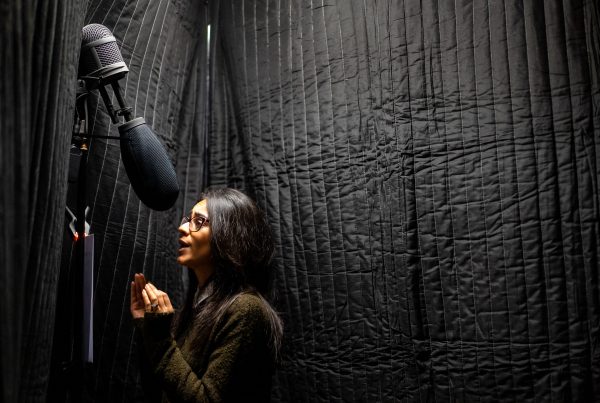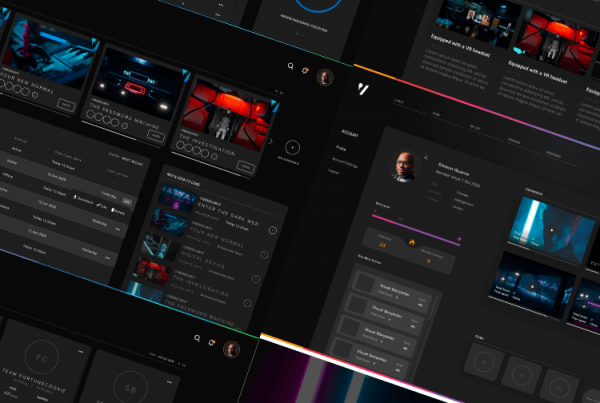Video Production and Lighting
In creating a high-quality piece of filmed material, lighting is one of the most important elements to consider. Having poor camera or audio quality will diminish the overall quality of a shoot, but lighting can do this and more, by heavily affecting the tone, composition and meaning of the piece.
In our learning modules and as part of our digital footprint we produce a lot of video content. Here are just a few of the elements and techniques we consider when choosing how to light our shots.
3 Point Lighting
3 Point lighting is the practice of lighting your subject from three specific angles. These three angles are known as the key, rim and the fill lights respectively.

Key, rim and fill lights
The key is appropriately named as it is the main light used to illuminate your subject. It is usually positioned in front of the subject at a slight 45° and has the highest luminosity of the three. The main purpose of the key light is to provide a well-lit view of the subject in frame so that it is clearly visible.
The rim light is positioned somewhere behind the subject, and will often be a slightly different hue to the other lights. This is to provide somewhat of an outline of your subject and clearly separate them from the background.
The fill light simply fills the rest of the frame with light to eliminate any unwanted shadows. It is usually positioned perpendicular to the key light, where it can best hit the recessed areas of shadow that the key is unable to hit.
Hard and Soft Light
So-called for the kinds of shadows they cast on the subject. Shadows cast from a soft light will have diffused edges, acting more like a gradient between light and dark. Hard lighting is it’s opposite, with a harsh outline that creates a border between light and shadow.

Hard and Soft Lighting
Soft light can be exceptionally good at making light seem more naturalistic, potentially providing a calm atmosphere to a shot by eliminating a lot of shadow. Whereas hard light often works with the shadows to accentuate hard features and make the subject look more ominous or threatening. This is only generally speaking of course as lighting is subjective, its other characteristics can be manipulated to help hard or soft light suit any desired meaning.
Diffusion
Diffusion is one method through which soft light is created. It usually involves a tool known as a diffuser sheet being placed between the light source and the subject, used to spread the light so that it hits a larger area. Some more expensive lighting setups have a diffusion setting built-in.
Bounce Lighting
Bouncing light off a surface like a wall is another method in which soft lighting can be created. It is especially effective when a diffuser sheet is not an option due to limited floor space.
Bounce lighting has the added benefit of slightly changing the hue of which light reflects back onto the subject. For example, if white light is bounced off of a green wall positioned behind the subject, it can create a similar effect to green backlighting since the light will reflect the colour of whichever surface it bounces off. The colour will not be as intense compared to if the shot was simply backlit, but it can be quite a nice solution if you require more subtle lighting.
Silhouette
Using limited lighting, or focusing your resources backlighting can prove an effective way to outline a striking silhouette. Using silhouette can help draw attention to a striking form whilst also providing an air of mystery since the subject is primarily cloaked in shadow. Silhouettes can work quite nicely for an establishing shot that demands an audience’s attention, after which the subject can step or be moved into the light to serve as a reveal.

A silhouette using limited lighting
Why use these techniques?
As previously mentioned, lighting is incredibly important when creating a high-quality piece of video content. The many narrative applications to these techniques have helped display tone and character whilst also drawing attention to certain objects in frame. Is your actor about to pick something up? Well then, why not keep the object well lit so we can clearly see what it is and state its importance. Has the script taken a dark turn, where a character once trusted has betrayed the group? Using hard lighting and reducing the luminosity of your rim light can drive this point home by making them seem more ominous and cloaked in darkness.
To this end lighting is such an invaluable tool for whenever we need to communicate something visually and leave it unspoken.
For more information on just how much lighting can affect the quality of a shoot, you can watch this YouTube video I created with Canon, where I delve more into the production side of things, highlighting how to improve your own live streaming setup.






